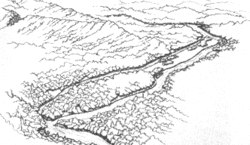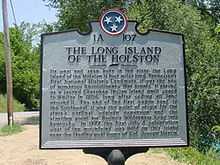Long Island (Tennessee)
|
Long Island of the Holston | |
 | |
 | |
| Nearest city | Kingsport, Tennessee |
|---|---|
| Coordinates | 36°31′49″N 82°33′39″W / 36.53028°N 82.56083°WCoordinates: 36°31′49″N 82°33′39″W / 36.53028°N 82.56083°W |
| Area | 840 acres (3.4 km2)[1] |
| Built | 1760 |
| Governing body | Private |
| NRHP Reference # | 66000733 |
| Significant dates | |
| Added to NRHP | October 15, 1966[2] |
| Designated NHLD | October 9, 1960[3] |
Long Island, also known as Long Island of the Holston, is an island in the Holston River at Kingsport in eastern Tennessee. The Long Island was a sacred council and treaty site among the Cherokee. Daniel Boone began from here to clear the Wilderness Road through the Cumberland Gap in 1775. It is a U.S. National Historic Landmark District. The island has been heavily transformed by industrial development, and NPS staff recommended withdrawal of National Historic Landmark status in 1996 due to loss of historic integrity.[3]
It has been suggested that the name "Tennessee" originated from the old Yuchi Indian word, "Tana-see," meaning "The Meeting Place," and that this may refer to The Long Island of the Holston River.[citation needed]
The Long Island of the Holston River was an important site for the Cherokee, colonial pioneers, and early settlers. Early settlements at the site were used as a staging ground for people following the Wilderness Road to Kentucky through the Cumberland Gap. First chartered in 1822, Kingsport became an important shipping port on the Holston River. Goods originating for many miles from the surrounding countryside were loaded onto barges for transport downstream to the Tennessee River at Knoxville. The young town lost its charter after a downturn its in fortunes precipitated by the Civil War.[citation needed]
Long Island of the Holston was declared a National Historic Landmark in 1960.[3][1]

Long Island's modern population peaked "between 1955 and 1963, with 517 residences and approximately 1,800 people. Although many upstanding citizens lived on Long Island, the neighborhood acquired a local reputation for violence and bootlegging."[4]
There are only a handful of houses on the island now. About half of Long Island now contains a park administered by the City of Kingsport. The other half of the island is the site of a waste treatment plant owned by Tennessee Eastman Chemical Company. Most of the island is within the corporate boundaries of Kingsport.[citation needed]
References
- ↑ 1.0 1.1 Frank B. Sarles, Jr., and Polly M. Rettig (June 4, 1976). National Register of Historic Places Inventory-Nomination: Long Island of the Holston PDF (32 KB). National Park Service and Accompanying seven photos, from 1958, 1972, and 1975 PDF (32 KB)
- ↑ "National Register Information System". National Register of Historic Places. National Park Service. 2007-01-23.
- ↑ 3.0 3.1 3.2 "Long Island of the Holston". National Historic Landmark summary listing. National Park Service. Retrieved 2008-07-01.
- ↑ Patricia Bernard Ezzell. "Long Island". Tennessee Encyclopedia on-line article. Tennessee Historical Society. Retrieved 2011-09-11.
Further reading
- Long, Howard. Kingsport: A Romance of Industry. Overmountain Press (October 1993)
- Spoden, Muriel M.C. Kingsport Heritage: The Early Years, 1700 to 1900. Johnson City, TN: The Overmountain Press, 1991
- Spoden, Muriel Millar Clark . The Long Island of the Holston: Sacred island of the Cherokee nation
- Williams, "Fort Robinson on the Holston," East Tennessee Historical Society Publications, no.4 (1932)
- Williams, Samuel C. Dawn of Tennessee Valley and Tennessee History (Johnson City, 1937)
- Williams, Tennessee During the Revolutionary War (Nashville, 1944)
- Wolfe, Margaret Ripley. Kingsport Tennessee: A Planned American City. University Press of Kentucky (November 1987)
External links
- LONG ISLAND OF THE HOLSTON, Tennessee, National Park Service
| ||||||||||||||||||||